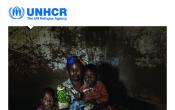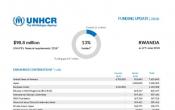Rwanda
Operation: Rwanda
Location
{"longitude":30,"latitude":-2,"zoom_level":8,"iso_codes":"'RWA'"}
By clicking on the icons on the map, additional information is displayed.
Key Figures
| 2017 year-end results | |
| 11,000 | Rwandan returnees received cash grants |
| 5,600 | Congolese households in camps and 235 Burundian refugees received cash grants |
| 5 | health facilities were equipped, constructed or rehabilitated |
| 100% | of people of concern have access to primary health care |
| 81% | of primary school-aged Congolese refugee children, and 95% of Burundian refugee children were enrolled in primary education in camps |
| 2018 planning figures | |
| 91% | of people of concern will be registered on an individual basis |
| 75% | of people of concern will have access to primary health care |
| 65% | of people of concern will have access to national education systems |
| 3,750 | children will be registered and issued documentation under regular birth registration procedure |
| 2,000 | semi-permanent shelters (duplex model) will be provided for Burundian refugees |
| 500 | people of concern will be provided with guidance on business and market opportunities |
Latest Updates and Related Links
People of Concern
9%
Increase in
2016
2016
| 2016 | 164,080 |
| 2015 | 151,173 |
| 2014 | 80,124 |

[["Refugees",156065],["Asylum-seekers",464],["Returned refugees",6105],["Others of concern",1446]]
Loading ...
Rwanda
< Back
2017
{"categories":[2013,2014,2015,2016,2017,2018],"budget":[46.99329576,51.77383169,123.04000345,101.21378467,104.378181188,98.77603889],"expenditure":[24.80532645,19.3520492,39.48045656,44.64500707,42.13502654,null]}
{"categories":[2013,2014,2015,2016,2017,2018],"p1":[44.64886676,49.14538088,122.417859367,95.18270004,96.813086748,95.47573026],"p2":[null,null,null,null,null,null],"p3":[2.344429,2.62845081,0.622144083,6.03108463,7.56509444,3.30030863],"p4":[null,null,null,null,null,null]}
{"categories":[2013,2014,2015,2016,2017,2018],"p1":[24.79354125,18.31857805,38.96277319,43.36483925,38.24165204,null],"p2":[null,null,null,null,null,null],"p3":[0.0117852,1.03347115,0.51768337,1.28016782,3.8933745,null],"p4":[null,null,null,null,null,null]}
Loading ...
CHOOSE A YEAR
- 2014
- 2015
- 2016
- 2017
- 2018
Operational context
Rwanda held peaceful elections in mid-2017 and remained politically stable. However due to the ongoing insecurity in Burundi and the Democratic Republic of the Congo (DRC), a slight increase (3 per cent) in refugee arrivals was observed, and the possibility of a further influx remains.The majority of refugees in Rwanda benefitted from prima facie refugee status and open borders. The Government of Rwanda continued to be outwardly committed to the principle of non-refoulement.
Limited land for, and limited capacity of, camps has resulted in overcrowded shelters, promiscuity and the creation of informal settlements with often poor living conditions.
Since the Government has banned the use of plastic in 2008, including plastic sheeting in the camps, the repair of shelter with plastic sheet roofing has been challenging.
In line with UNHCR’s organizational priority to move towards the use of cash-based interventions (CBIs), a baseline assessment was undertaken between February and April 20147 in three camps to identify the risks and benefits of rolling out cash for core relief items (CRIs). As a result, a number of safeguards to confront protection risks that could potentially arise upon the roll-out of CBIs in the camps were recommended. In-kind return packages for Rwandan returnees were replaced with cash grants.
The Multi-Year, Multi-Partner Strategy for 2018-2022 was finalized. This will focus on refugees’ inclusion in national plans and will involve Government and development partners for sustainability in the medium to longer-term.
Population trends
In 2017, Rwanda continued to host refugees from Burundi and the DRC. At year’s end, the refugee population stood at 162,300, with some 88,200 from Burundi, 74,000 from the DRC and 31 of various nationalities. In addition, there were 445 asylum-seekers, some 8,700 living in refugee-like situations (inactive Congolese asylum-seekers residing in camps) and 1,800 Rwandan spouses of refugees and children of Rwandan and refugee parents. Furthermore, the number of Rwandan returnees reached close to 17,100.Key achievements
- The Office scaled up its capacity to receive Rwandan returnees in order to ensure that all registered refugees in countries of asylum who wished to voluntary repatriate to Rwanda would be able to, prior to the deadline for ending UNHCR-facilitated return at the end of 2017. Close to 17,100 returnees were assisted with return packages in the form of cash grants.
- As an operational priority, the plastic sheet roofing of some 3,360 shelters across the Congolese camps was replaced with corrugated iron sheet roofing.
Unmet needs
- Lack of resources to continue the provision of food assistance in full rations. Ration cuts were effected by WFP in 2017 and expected to deepen in 2018. Food insecurity is severe particularly for vulnerable persons.
- Only 7.5 per cent of Burundian refugees residing in urban areas were provided with individual protection documentation.
- Due to lack of land in Congolese camps, some 1,700 shelters and latrines could not be constructed.
Working environment
While the overall security situation in Rwanda remains calm, instability in neighbouring Burundi and eastern Democratic Republic of the Congo (DRC), where elections have been postponed to next year, continues to present the possibility of a sudden influx of refugees.Rwanda has been hosting refugees for decades and today it is home to nearly 165,000 refugees and asylum-seekers from the DRC and Burundi. The Government has maintained open borders and ensures freedom of movement and the right to work for all refugees.
Key priorities
UNHCR’s key strategy for 2017 is to further encourage the socio-economic inclusion of refugees and reduce dependency on humanitarian aid through a multifaceted strategy, including through the continued integration of refugees into national education and healthcare systems, and implementing a joint Government-UNHCR multi-year market-based livelihoods strategy. This strategy foresees a transition from in-kind to cash-based interventions, and includes strategic partnerships with the Government, development actors and UN agencies, to mainstream refugees into national programs.With women and children representing over 80 per cent of the refugee population in Rwanda, child protection and SGBV programs are being prioritized in all refugee locations. In addition, resettlement is also prioritized for Congolese refugees living in protracted situations.
A funding shortfall would impact UNHCR’s ability to upgrade the already overcrowded communal living spaces occupied by over 11,000 Burundian refugees and the temporary shelters of several Congolese refugee families, which present a range of health and protection risks. Funding is needed to ensure more dignified living conditions. UNHCR’s water, sanitation and health (WASH) programs have so far succeeded in achieving the minimum standards but further funding support is required to ensure the health of refugees.


